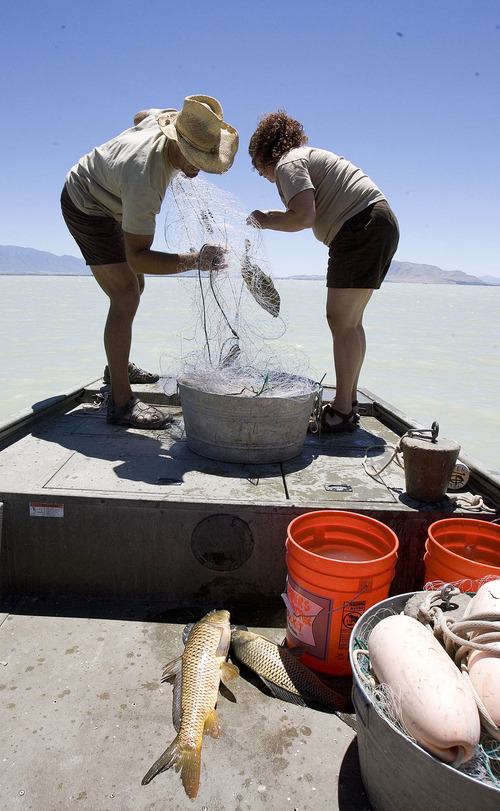This is an archived article that was published on sltrib.com in 2012, and information in the article may be outdated. It is provided only for personal research purposes and may not be reprinted.
Two biologists slowly rein in a net from the depths of Utah Lake, plucking out entangled fish one by one to be separated into orange buckets.
They pull in a few carp and white bass, but the true prize is a 1-pound, 14-inch June sucker, one of Utah's most endangered fish.
The nets are set out to measure the sucker population and progress made by the June Sucker Recovery Implementation Program to pull the fish back from the brink of extinction.
When the program began in 2002, as few as 500 fish per year were returning to the lake after spawning in the Provo River. That number now has risen to about 3,000 spawning suckers per year, with 280,000 fish stocked in the lake since 1998, program coordinator Mike Mills said.
"This is the most suckers we've observed since the the program got started and definitely since they've been listed as endangered," Mills said.
The June sucker originally was listed as an endangered species in 1986 and remains on the list along with six other Utah fish, according to the Utah Division of Wildlife Services.
So far, the program has focused on keeping the younger suckers away from predators, raising them at a hatchery until they are ready to be introduced into the lake and eliminating carp, which destroy the habitat for smaller fish to hide in while they are still growing.
The hatchery has stocked 50,000 to 80,000 young fish in the lake and recovery biologists have removed 8 million pounds of carp since 2008, Mills said.
Mills said another problem is an area of backwater where the Provo River meets the lake and halts the progress of larval fish that can't swim strongly enough, starving them or leaving them as easy food sources for other fish heading upstream to spawn.
One proposed solution is to divert the river and create a delta north of the current meeting place between the river and lake. Mills said the delta would provide vegetation and smaller ponds that would provide ideal environments for the baby fish to grow.
"That type of habitat is what June suckers need to survive and get away from predators," Mills said.
The recovery project has made progress, but still needs to remove 35 million more pounds of carp from the lake. Natural reproduction from the suckers themselves must also continue.
Mills acknowledges there is a long way to go to move the fish off the endangered species list, but also said he realizes the significant impact the recovery effort has made.
"We've come so far," Mills said. "We're not at a point [anymore] where we're worried about the species going extinct, and we've achieved a place where we've stocked enough that we're not going to lose everything."
About the June sucker
The June sucker, or Chasmistes liorus, occurs naturally in Utah Lake and the Provo River, and nowhere else in the world.
Although the species was once abundant in Utah Lake, it is now extremely rare. The June sucker is on the federal endangered species list, and population recovery efforts are ongoing.
June suckers are members of the sucker family, but they are not bottom feeders. The species' jaw structure allows June suckers to feed on zooplankton in the middle of the water column.
June sucker adults leave Utah Lake and swim up the Provo River to spawn each June. Spawning occurs in shallow riffles over gravel or rock. Fertilized eggs sink to the stream bottom, where they hatch in about four days.
Source • Utah Division of Wildlife Resources















